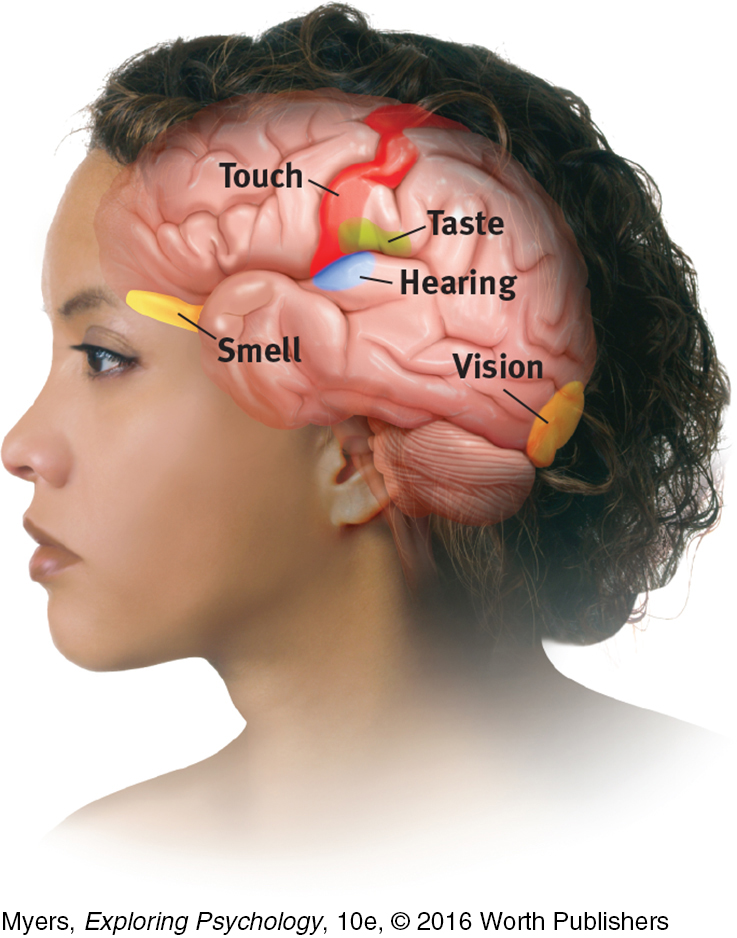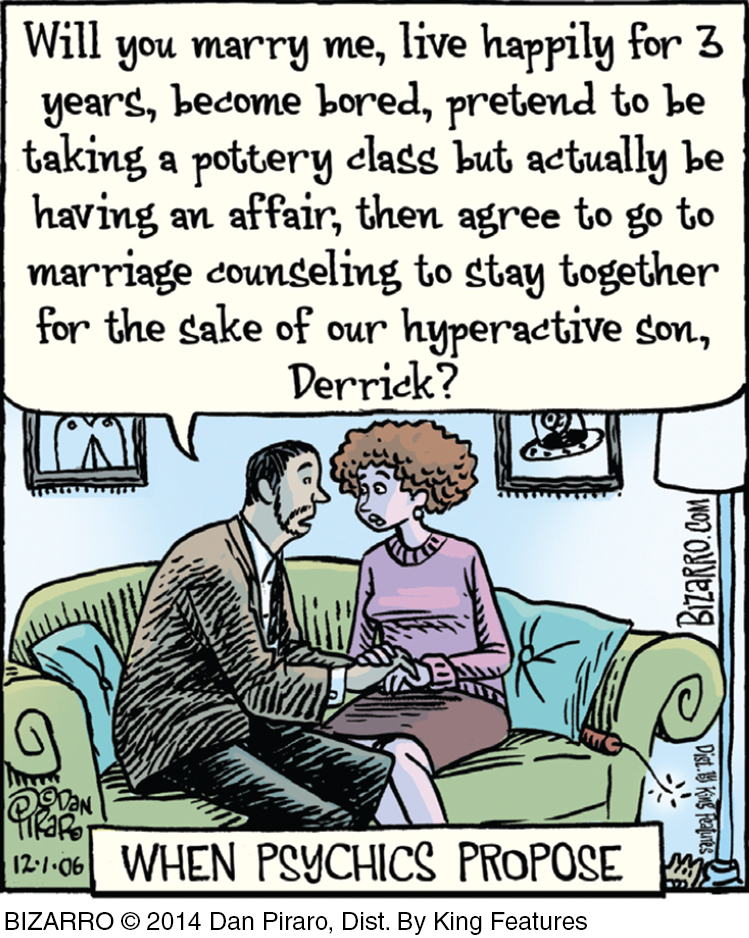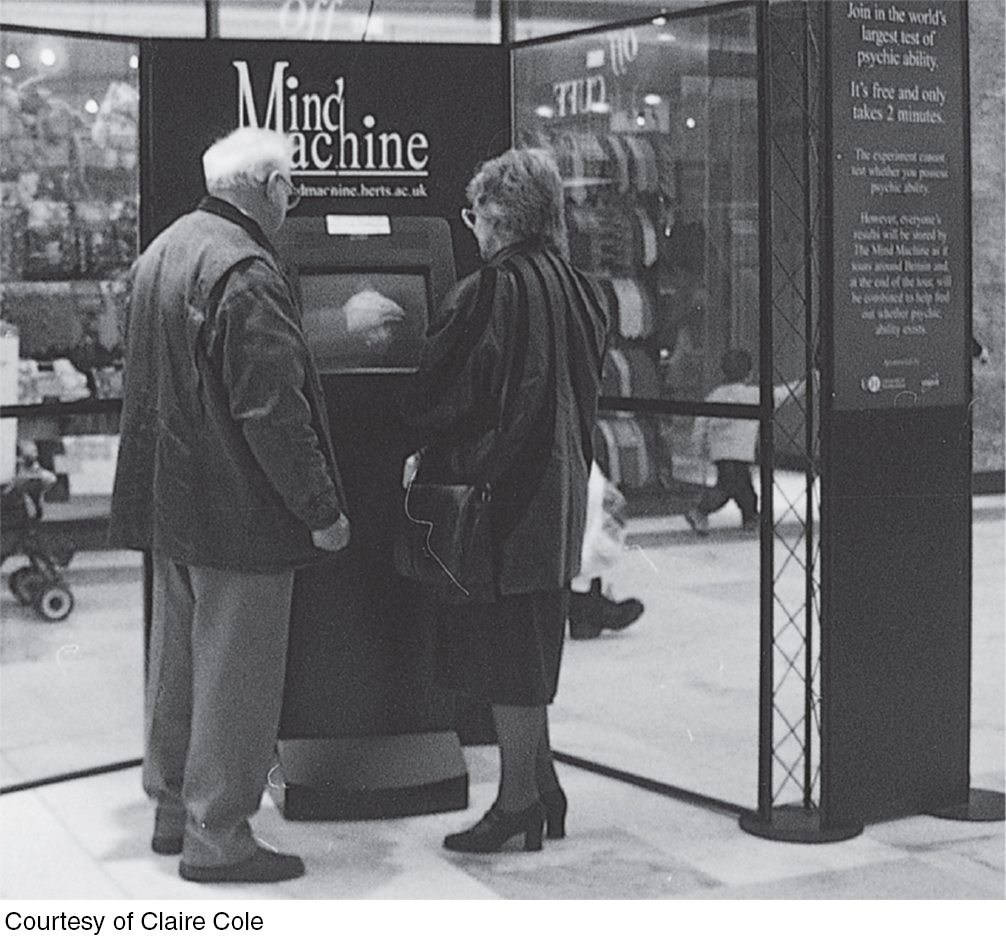18.3 Sensory Interaction
18-
Our senses—
sensory interaction the principle that one sense may influence another, as when the smell of food influences its taste.
Thus, to savor a taste, we normally breathe the aroma through our nose—
Vision and hearing may similarly interact. A weak flicker of light is more easily visible when accompanied by a short burst of sound (Kayser, 2007). And a sound may be easier to hear with a visual cue. If I [DM], as a person with hearing loss, watch a video with simultaneous captioning, I have no trouble hearing the words I am seeing. I may therefore think I don’t need the captioning, but if I then turn off the captioning, I suddenly realize I do need it. The eyes guide the ears (FIGURE 18.11).

But what do you suppose happens if the eyes and the ears disagree? What if we see a speaker saying one syllable while we hear another? Surprise: We may perceive a third syllable that blends both inputs. Seeing the mouth movements for ga while hearing ba we may perceive da. This phenomenon is known as the McGurk effect, after its discoverers, Scottish psychologist Harry McGurk and his assistant John MacDonald (1976). For all of us, lip reading is part of hearing.
Touch also interacts with our other senses. In detecting events, the brain can combine simultaneous touch and visual signals, thanks to neurons projecting from the somatosensory cortex back to the visual cortex (Macaluso et al., 2000). Touch even interacts with hearing. In one experiment, researchers blew a puff of air (such as our mouths produce when saying pa and ta) on the neck or hands as people heard either these sounds or the more airless sounds ba or da. The result? People more often misheard ba or da as pa or ta when played with the faint puff (Gick & Derrick, 2009). Thanks to sensory interaction, they heard with their skin.
Our sensory experiences also interact with other aspects of our psychology. Our brain even blends our tactile and social judgments, as demonstrated in these playful experiments:
After holding a warm drink rather than a cold one, people were more likely to rate someone more warmly, feel closer to them, and behave more generously (IJzerman & Semin, 2009; Williams & Bargh, 2008). Physical warmth promotes social warmth.
After being given the cold shoulder by others in an experiment, people judge the room as colder than do those treated warmly (Zhong & Leonardelli, 2008). Social exclusion literally feels cold.
Sitting at a wobbly desk and chair makes others’ relationships seem less stable (Kille et al., 2013).
When leaning to the left—
by sitting in a left- rather than right- leaning chair, or squeezing a hand- grip with their left hand, or using a mouse with their left hand— people lean more left in their expressed political attitudes (Oppenheimer & Trail, 2010). When holding a soft ball, American students become more likely to categorize a face as a Democrat rather than a Republican, and vice versa when holding a hard ball (Slepian et al., 2012).
 IMMERSIVE LEARNING Are you wondering how researchers test these kinds of questions? Try LaunchPad’s How Would You Know If a Cup of Coffee Can Warm Up Relationships?
IMMERSIVE LEARNING Are you wondering how researchers test these kinds of questions? Try LaunchPad’s How Would You Know If a Cup of Coffee Can Warm Up Relationships?
embodied cognition the influence of bodily sensations, gestures, and other states on cognitive preferences and judgments.
These examples of embodied cognition illustrate how brain circuits processing bodily sensations connect with brain circuits responsible for cognition. We think from within a body.
So, the senses interact: As we attempt to decipher our world, our brain blends inputs from multiple channels. For many people, an odor, perhaps of mint or chocolate, can evoke a sensation of taste (Stevenson & Tomiczek, 2007). But in a few select individuals, the senses become joined in a phenomenon called synesthesia, where one sort of sensation (such as hearing sound) involuntarily produces another (such as seeing color). Thus, hearing music may activate color-
* * *
For a summary of our sensory systems, see TABLE 18.2. The river of perception is fed by streams of sensation, cognition, and emotion.
If perception is the product of these three sources, what can we say about extrasensory perception, which claims that perception can occur apart from sensory input? For more on that question, see Thinking Critically About: ESP—

Summarizing the Senses
| Sensory System | Source | Receptors | Key Brain Areas |
|---|---|---|---|
| Vision | Light waves striking the eye | Rods and cones in the retina | Occipital lobes |
| Hearing | Sound waves striking the outer ear | Cochlear hair cells in the inner ear | Temporal lobes |
| Touch | Pressure, warmth, cold | Receptors, most in the skin, detect pressure, warmth, cold, and pain | Somatosensory cortex |
| Taste | Chemical molecules in the mouth | Basic tongue receptors for sweet, sour, salty, bitter, and umami | Frontal temporal lobe border |
| Smell | Chemical molecules breathed in through the nose | Millions of receptors at top of nasal cavity | Olfactory bulb |
| Body position— |
Any change in position of a body part, interacting with vision | Kinesthetic sensors in joints, tendons, and muscles | Cerebellum |
| Body movement— |
Movement of fluids in the inner ear caused by head/body movement | Hair- |
Cerebellum |
THINKING CRITICALLY ABOUT
ESP—
18-
extrasensory perception (ESP) the controversial claim that perception can occur apart from sensory input; includes telepathy, clairvoyance, and precognition.
Without sensory input, are we capable of extrasensory perception (ESP)? Are there indeed people—
The most testable and, for this discussion, most relevant ESP claims are
telepathy: mind-
to- mind communication. clairvoyance: perceiving remote events, such as a house on fire in another state.
precognition: perceiving future events, such as an unexpected death in the next month.
Closely linked is psychokinesis, or “mind movement,” such as levitating a table or influencing the roll of a die. (The claim is illustrated by the wry request, “Will all those who believe in psychokinesis please raise my hand?”)
If ESP is real, we would need to overturn the scientific understanding that we are creatures whose minds are tied to our physical brains and whose perceptual experiences are built of sensations. Sometimes new evidence does overturn our scientific preconceptions.
parapsychology the study of paranormal phenomena, including ESP and psychokinesis.
Most research psychologists and scientists have been skeptical that paranormal phenomena exist. But in several reputable universities, parapsychology researchers perform scientific experiments searching for possible ESP (Storm, 2010a, b; Turpin, 2005). Before seeing how they do so, let’s consider some popular beliefs.

Premonitions or Pretensions?
Can psychics see into the future? Although one might wish for a psychic stock forecaster, the tallied forecasts of “leading psychics” reveal meager accuracy. During the 1990s, the tabloid psychics were all wrong in predicting surprising events. (Madonna did not become a gospel singer, the Statue of Liberty did not lose both its arms in a terrorist blast, Queen Elizabeth did not abdicate her throne to enter a convent.) And the psychics have missed big-
The psychic visions offered to police departments have been no more accurate than guesses made by others (Nickell, 1994, 2005; Radford, 2010; Reiser, 1982). Their sheer volume does, however, increase the odds of an occasional correct guess, which psychics can then report to the media. Police departments are wise to all this. When researchers asked the police departments of America’s 50 largest cities whether they ever had used psychics, 65 percent said No (Sweat & Durm, 1993). Of those that had, not one had found them helpful.
Psychics’ vague predictions sometimes sound correct when later retrofitted to match events. Nostradamus, a sixteenth-
Are the spontaneous “visions” of everyday people any more accurate? Do dreams, for example, foretell the future, as people from both Eastern and Western cultures tend to believe—
Given the billions of events in the world each day, and given enough days, some stunning coincidences are sure to occur. By one careful estimate, chance alone would predict that more than a thousand times a day someone on Earth will think of another person and then, within the next five minutes, learn of that person’s death (Charpak & Broch, 2004). Thus, when explaining an astonishing event, we should “give chance a chance” (Lilienfeld, 2009). With enough time and people, the improbable becomes inevitable.
Putting ESP to Experimental Test
When faced with claims of mind reading or out-
This scientific attitude has led both believers and skeptics to agree that what parapsychology needs is a reproducible phenomenon and a theory to explain it. Parapsychologist Rhea White (1998) spoke for many in saying “The image of parapsychology that comes to my mind, based on nearly 44 years in the field, is that of a small airplane [that] has been perpetually taxiing down the runway of the Empirical Science Airport since 1882 … its movement punctuated occasionally by lifting a few feet off the ground only to bump back down on the tarmac once again. It has never taken off for any sustained flight.”
“To be sure of hitting the target, shoot first and call whatever you hit the target.”
Writer-
“A person who talks a lot is sometimes right.”
Spanish proverb
How might we test ESP claims in a controlled, reproducible experiment? An experiment differs from a staged demonstration. In the laboratory, the experimenter controls what the “psychic” sees and hears; on stage, the psychic controls what the audience sees and hears.
Daryl Bem, a respected social psychologist, has been a skeptic of stage psychics; he once quipped that “a psychic is an actor playing the role of a psychic” (1984). Yet he reignited hopes for replicable evidence with nine experiments that seemed to show people anticipating future events (2011). In one, when an erotic scene was about to be displayed in one of two randomly selected screen placements, Cornell University participants guessed the right placement 53.1 percent of the time (beating 50 percent by a small but statistically significant margin).

Despite Bem’s published research having survived critical reviews by a top-
Anticipating such skepticism, Bem has made his computer materials available to anyone who wishes to replicate his studies. Multiple attempts have since been made, with minimal success and continuing controversy (Bem et al., 2014; Galak et al., 2012; Ritchie et al., 2012; Wagenmakers, 2014). Regardless, science is doing its work. It has been open to a finding that challenges its own assumptions. And then, through follow-
“At the heart of science is an essential tension between two seemingly contradictory attitudes—
Carl Sagan (1987)
One skeptic, magician James Randi, has had a long-
RETRIEVE IT
Question
If an ESP event occurred under controlled conditions, what would be the next best step to confirm that ESP really exists?
* * *
To feel awe, mystery, and a deep reverence for life, we need look no further than our own perceptual system and its capacity for organizing formless nerve impulses into colorful sights, vivid sounds, and evocative smells. As Shakespeare’s Hamlet recognized, “There are more things in Heaven and Earth, Horatio, than are dreamt of in your philosophy.” Within our ordinary sensory and perceptual experiences lies much that is truly extraordinary—